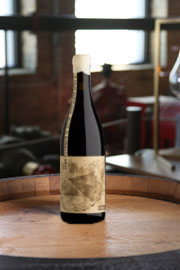- Analysis
- Vineyards
- Vinification and Aging
- Tasting Notes
- 2013 Vintage Notes
BLANKbottle “33.33333” Organic Syrah 2014
Wine of Origin
Voor-Paardeberg (ward within Paarl W.O)
Varietals
100% Syrah
Analysis
Wine Maker: Pieter H. Walser Alcohol: 14.0%
Owning a farm limits you to the vineyards on your specific farm. I love traveling and experiencing many different areas. I want to make area specific wines, wines that will be ambassadors for areas. I harvest 55 tons from 47 vineyards; 26 different varietals and growing – anything from Fernao Pirez to Cabernet. In the 2015 harvest, I drove 13 000 killometers in 100 days to pick my grapes.
Vineyard-site selection is where all wine begins, and to me personally, one of my most crucial decisions. The Syrah for this wine comes from a Organically farmed single vineyard in the Voor-Paardeberg.
To take terroir to the next level, one wants to put everything that comes from the vineyard into the wine. So why remove the stems? It is part of the grapes and terroir. When we picked the grapes, I took a bunch and stripped the stem clean. I tasted the berries, but also ate the stem. Pure spice, so interesting. So my thoughts were: If I ferment this wine with about 30% of the stems in the wine (you call this whole bunch fermentation) I could get some of that exciting spice into the Syrah. So I chucked 33.33333% of the grapes into a fermentation vessel and crushed it with my feet.
The other grapes I de-stemmed (took the stems out) and fermented it in a open-top fermentation vessel. I blended it afterwards and took it to a old 700 liter barrel. It aged there for 15 months and was put to bottle. The label is a pencil sketch I did on a piece of paper I deliberately spilled a cup of tea on. It is a picture of a camera taking a shot of a stem. But only 33.333333 % of the lens is exposed to the stem. The rest is blocked out. Showing 33.33333% exposure to the stem.
A classic example of a “European” style Syrah. Aromas of spice, dark cherry, and wild strawberry fruit, complemented by subtle hints of freshly cracked black pepper and smoke on a smooth full bodied palate. A versatile wine partnered well with beef, fillet, lamb, venison, smoked gammon and exotic cheeses.
An exceptional year, with much higher yields – especially in dryland areas – and the promise of very high quality wines.
Initial vineyard growth was slow due to late cold fronts in August, followed by cool, wet weather at the beginning of the growing season. This led to a high incidence of disease, and rainfall mid-November further hampered effective disease control by creating challenging spraying conditions and limiting access to vineyards. As a result, downy mildew resulted in crop losses early on in the season in some areas. The climate was favourable for flowering thereafter, and good berry set was obtained. However, after the high rainfall mid-November, vigorous growth ensued, requiring extra input to ensure high grape quality and disease prevention via good canopy aeration and sunlight exposure. Ideal dry, moderate conditions reigned during ripening in January and mid-February, after which a warm period accelerated ripening and resulted in great pressure on intakes in some areas. Cooler weather in March enhanced colour formation and flavour retention in later red cultivars. Regular rainfall at the end of March delayed ripening again and extended the harvest to mid-April.

